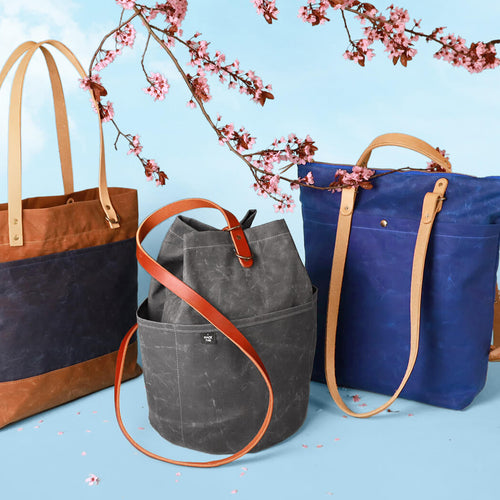THE MAKER KIT.


Fast forward a few years, and we’re still cutting and prepping bag making materials, but now we package them up and send them to makers around the world. In order to scale in this way, we’ve had to outsource our fabric and leather cutting to local manufacturers, who can process a much higher volume of materials quickly, while ensuring precision and consistency. But much of our production still takes place in-house, where our team counts every rivet by hand, individually packs hardware into little baggies, rolls leather straps, pulls the correct pieces of pre-cut fabric, and packs it all into a maker kit tube, before it gets delivered to your doorstep! This is the story of how a maker kit comes to life…

_________________________________________________________________________________________________________________
1. Fabric is cut with an industrial cutting machine

When a pattern is finalized and we are absolutely certain that the measurements are correct, we send those measurements to a local fabric cutter, who programs their industrial fabric cutting machine to these specifications. In the video below, you can see a worker at Spooltown, a women-owned sewing factory, cutting spring green waxed canvas for our Slabtown full maker kits! Spooltown is even able to pre-punch rivet holes and pre-snip notches into the fabric. We love that we are able to support local small-batch manufacturing here in Portland this way.
2. Fabric is sorted at Klum House
Cut fabric is then delivered to Klum House, where we do a quality-control check, making sure that the measurements are accurate and the fabric itself is clean, without any strange markings or uneven wax. In this video, Ellie is sorting and organizing cut pieces of waxed canvas in the studio.
3. Pre-set color ways are rolled and organized
 To streamline our fulfillment process, we typically pre-roll a bunch of fabric in our preset color ways and store the rolls in labeled bins for easy-access. All of the pre-cut fabric needed to make one bag is carefully rolled together and secured with a rubber band, along with an instructions booklet and a scrap of waxed canvas, which helps protect the main fabric from getting market by the rubber band and gives makers a bit of scrap to practice sewing with. When kit orders with custom colors come in, we pull and roll fabric this way on demand to make sure makers get exactly what they’d like!
To streamline our fulfillment process, we typically pre-roll a bunch of fabric in our preset color ways and store the rolls in labeled bins for easy-access. All of the pre-cut fabric needed to make one bag is carefully rolled together and secured with a rubber band, along with an instructions booklet and a scrap of waxed canvas, which helps protect the main fabric from getting market by the rubber band and gives makers a bit of scrap to practice sewing with. When kit orders with custom colors come in, we pull and roll fabric this way on demand to make sure makers get exactly what they’d like!
4. Leather is cut with a hydraulic press
 To cut all of the leather pieces needed to make our bags—tote straps, handles, backpack straps, reinforcement tabs, leather washers, zipper pulls—we first create leather dies, which are like stencils made of steel. These dies allow a large quantity of pieces to be cut very precisely, with rounded or straight ends and all of the correct-sized holes exactly where they need to be.
To cut all of the leather pieces needed to make our bags—tote straps, handles, backpack straps, reinforcement tabs, leather washers, zipper pulls—we first create leather dies, which are like stencils made of steel. These dies allow a large quantity of pieces to be cut very precisely, with rounded or straight ends and all of the correct-sized holes exactly where they need to be.
We then work with a local saddle maker named LP, who uses these dies in conjunction with his hydraulic press (also called a “clicker press”) to cut our leather pieces. We use as much of the hide as possible. To minimize waste, we use offcuts to make smaller pieces, like leather washers and zipper pulls, or we sell them in our online shop as leather scrap grab bags!
5. Leather is organized and bundled in-house
 After LP cuts the leather, it is delivered to Klum House where, much the like the fabric, it goes through a quality control check. Because leather is an organic material, it’s normal for it to have some slight inconsistencies in color and texture. We are big believers in embracing those imperfections (and minimizing waste!). That said, if there are any straps that are particularly marked or discolored, we set those aside and use them for sample making, teaching, or for KH staff and friends who don’t mind!
After LP cuts the leather, it is delivered to Klum House where, much the like the fabric, it goes through a quality control check. Because leather is an organic material, it’s normal for it to have some slight inconsistencies in color and texture. We are big believers in embracing those imperfections (and minimizing waste!). That said, if there are any straps that are particularly marked or discolored, we set those aside and use them for sample making, teaching, or for KH staff and friends who don’t mind!
6. Hardware is counted by hand and put into baggies
Because our hardware comes in three different colors (brass, antique brass, and black) and our leather comes in three different colors (tan, brown, and black), there are nine different combinations of leather and hardware (!!!) that get packed together, stored, and labeled, so we can easily grab the correct one when orders come through.



7. Ellie picks up tubes from a local manufacturer
_________________________________________________________________________________________________________________
8. Tubes are stickered by hand in-house
_________________________________________________________________________________________________________________
9. Kit orders are assembled and packed


_________________________________________________________________________________________________________________
10. Kits are mailed out and delivered to YOU!
 Finally, kits are packed into these triangular USPS priority mailing boxes, picked up by our pal the postman, and begin their journey to your doorstep. As you can see, before you begin making, your materials have already underdone quite the production process! It takes a lot of labor and the help of several different local manufacturers to get all of the ingredients to a state where they are ready for you to take over and turn them into a beautiful finished bag.
Finally, kits are packed into these triangular USPS priority mailing boxes, picked up by our pal the postman, and begin their journey to your doorstep. As you can see, before you begin making, your materials have already underdone quite the production process! It takes a lot of labor and the help of several different local manufacturers to get all of the ingredients to a state where they are ready for you to take over and turn them into a beautiful finished bag.
_________________________________________________________________________________________________________________
SHOP MAKER KITS




